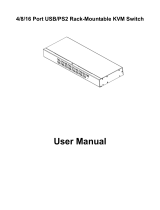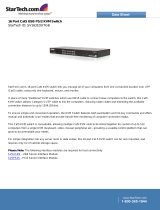2
Table of Contents
Features.. ......................................................................................... p. 3
Package Includes….. ...................................................................... p. 3
Accessories… ................................................................................. p. 3
Configuration… .............................................................................. p. 4
Front View ............................................................................... p. 4
Rear View ................................................................................ p. 5
Installation…….. ............................................................................ p. 5
Pre-Installation Guidelines ...................................................... p. 5
Connecting the NetCommander KVM System….. ................ p. 5
NetCommander Server Interface Units ................................... p. 6
Connecting the Power Supply ................................................. p. 7
Resetting the KVM Switch ..................................................... p. 7
Rackmount Considerations ..................................................... p. 8
Rackmounting the NetCommander KVM ............................. p. 8
Cascading NetCommander KVM Switches............................ p. 9
Connecting the B050-000 or B051-000 ................................ p. 10
Operation ...................................................................................... p. 10
Basic Operation ..................................................................... p. 10
Keyboard Hotkeys ................................................................. p. 10
On-Screen Display ................................................................ p. 11
Navigating the OSD .............................................................. p. 11
Selecting a Computer ............................................................ p. 11
OSD Settings (F2) ................................................................. p. 11
General Settings .................................................................... p. 12
F7 Defaults ............................................................................ p. 14
Port Settings .......................................................................... p. 14
Time Settings......................................................................... p. 15
Security ................................................................................. p. 16
User Settings ......................................................................... p. 17
OSD Help Window (F1) ....................................................... p. 17
Scanning Computers (F4) ..................................................... p. 17
Tuning (F5) ........................................................................... p. 18
Moving the Label (F6) .......................................................... p. 18
Firmware Upgrade ........................................................................ p. 18
Firmware Upgrade System Requirements ............................ p. 18
Upgrading the KVM Firmware ............................................. p. 18
KVM Switch/SIU Reset ........................................................ p. 21
Troubleshooting ............................................................................ p. 22
USB/SUN Combo Keys ............................................................... p. 23
Specifications ................................................................................ p. 23
1-Year Limited Warranty/Warranty Registration .......................... p. 24
Español ....................................................................................... p. 25
Françis ....................................................................................... p. 51























